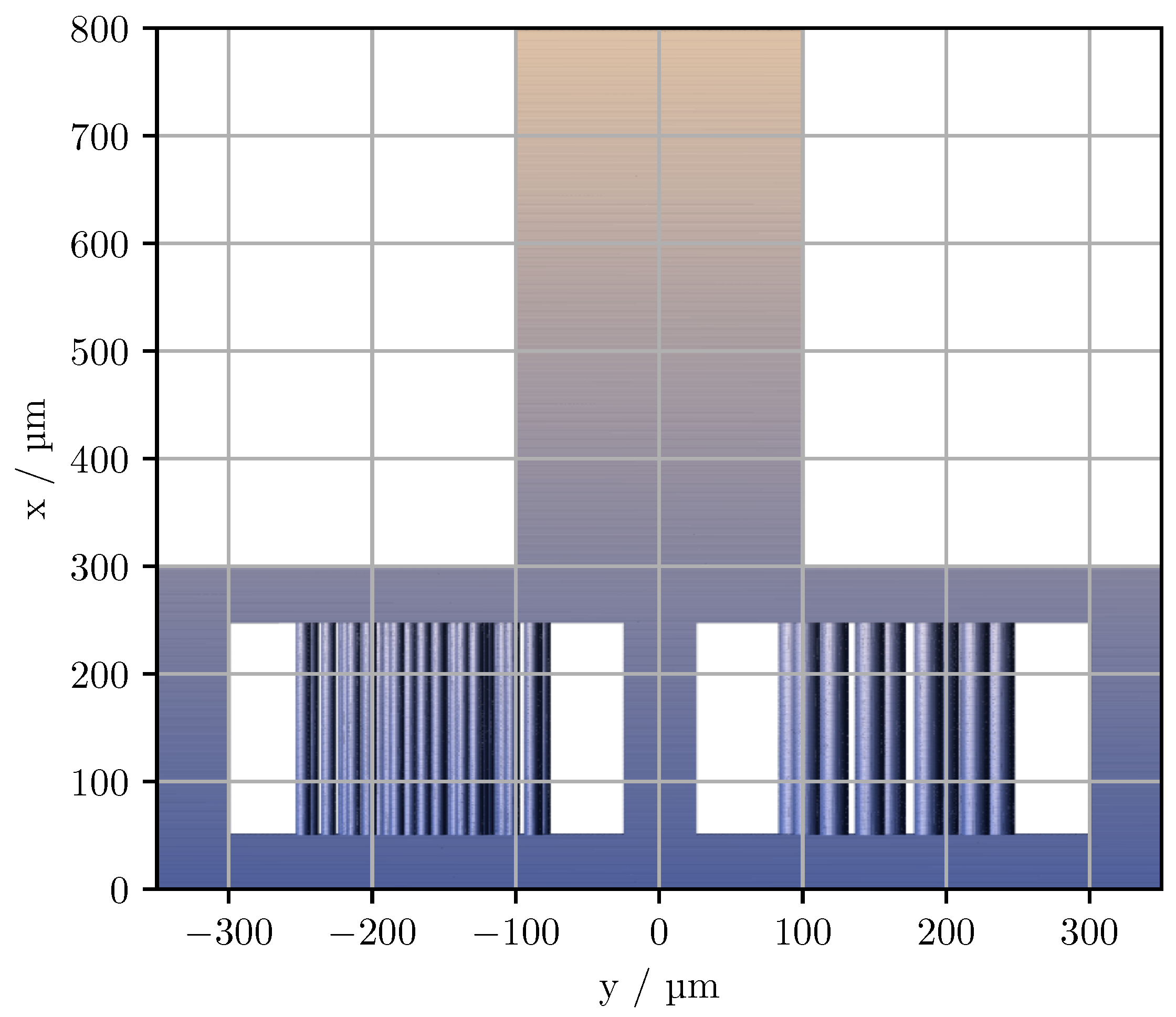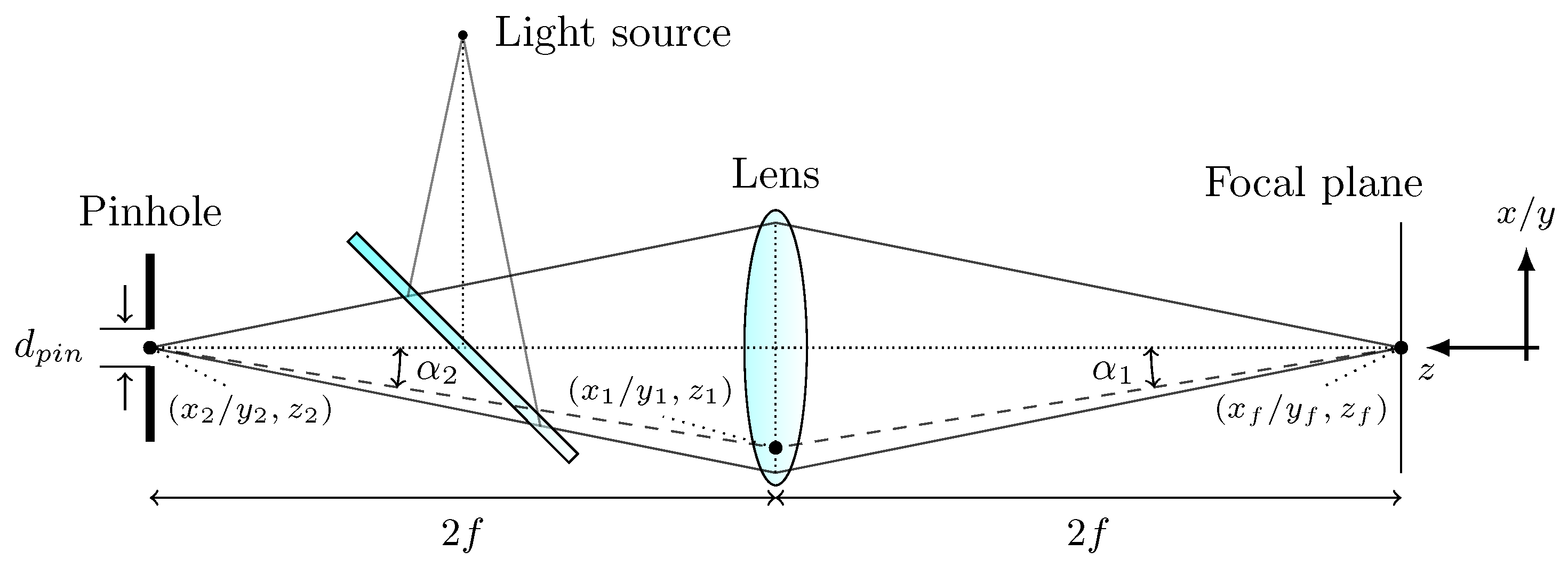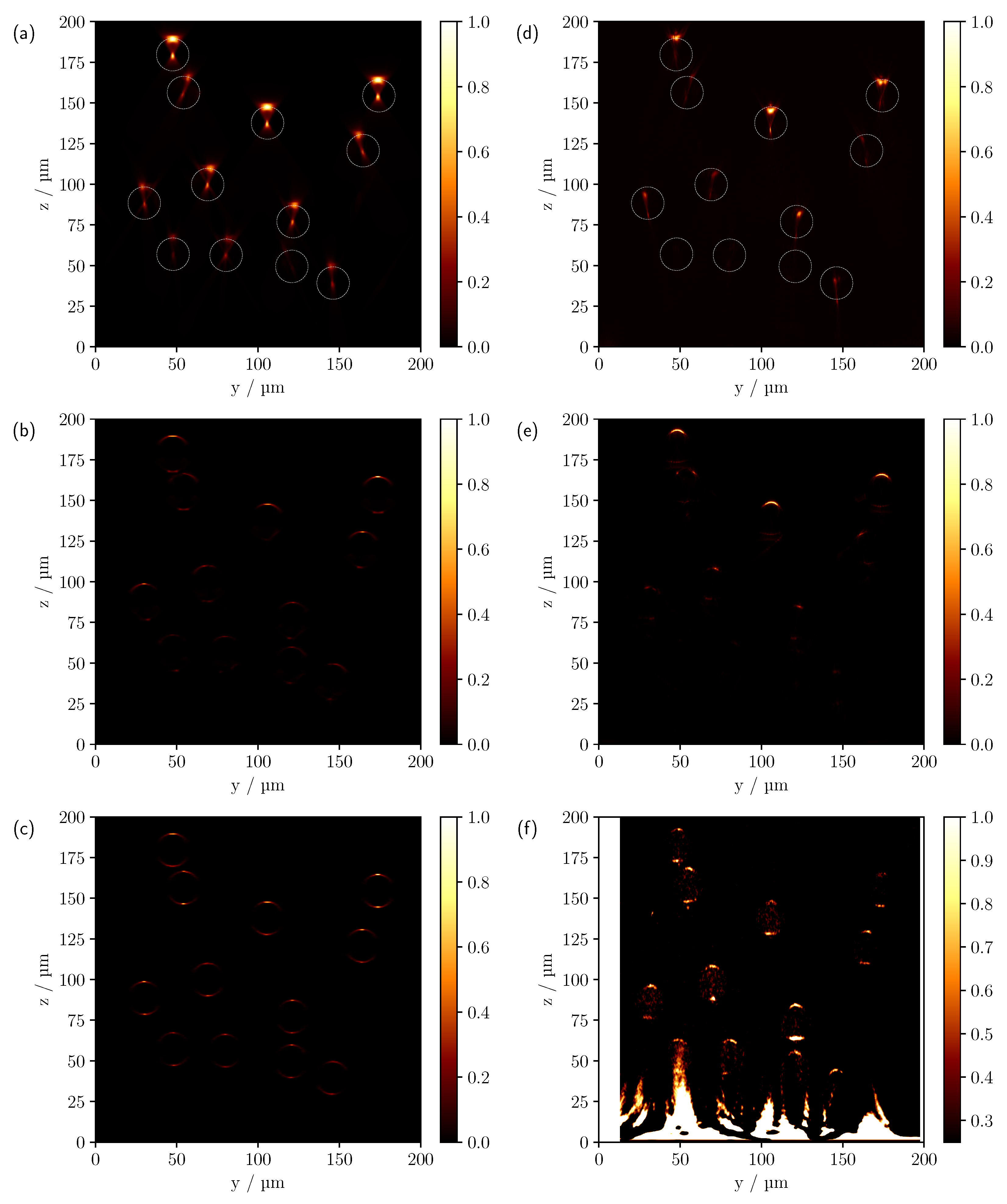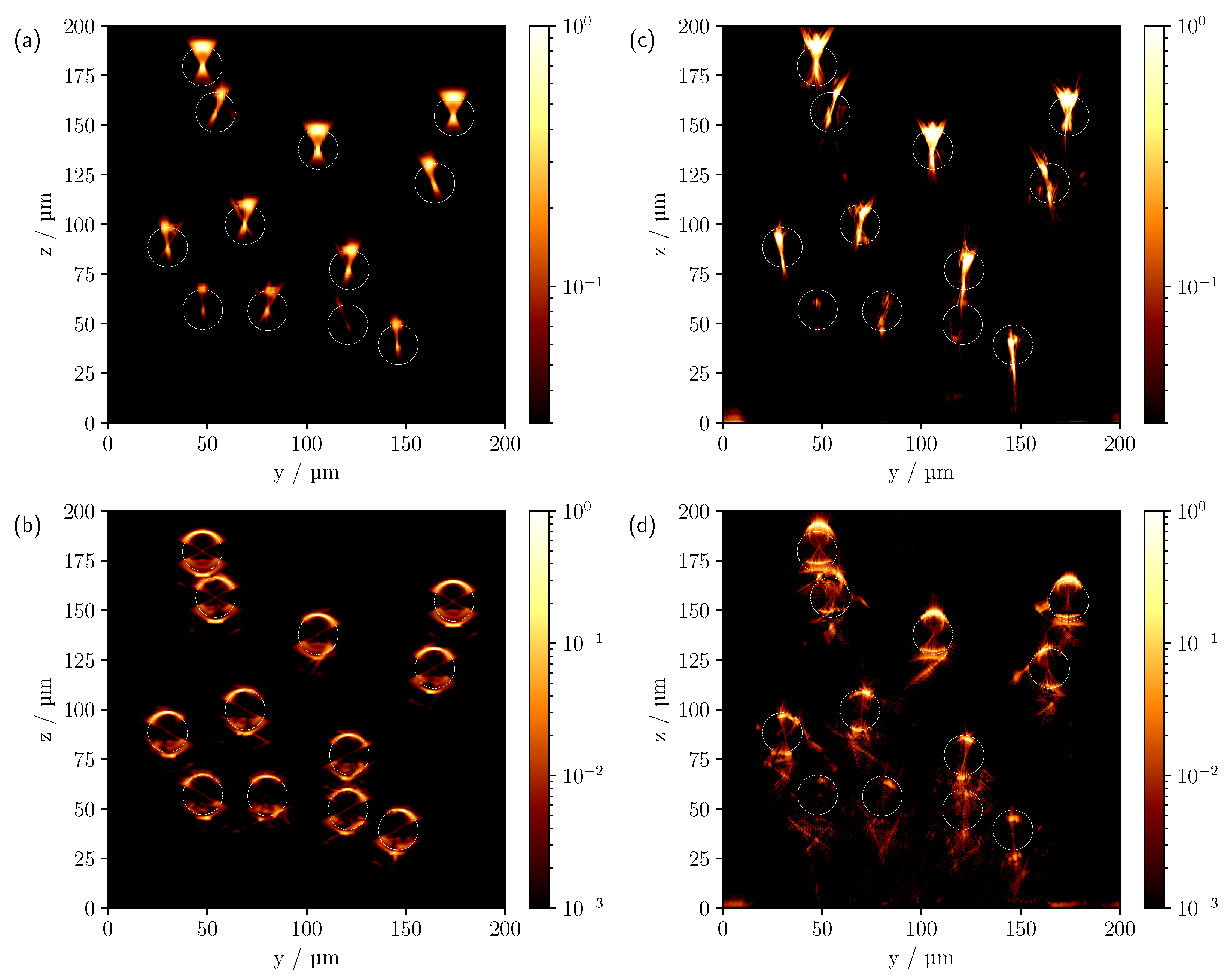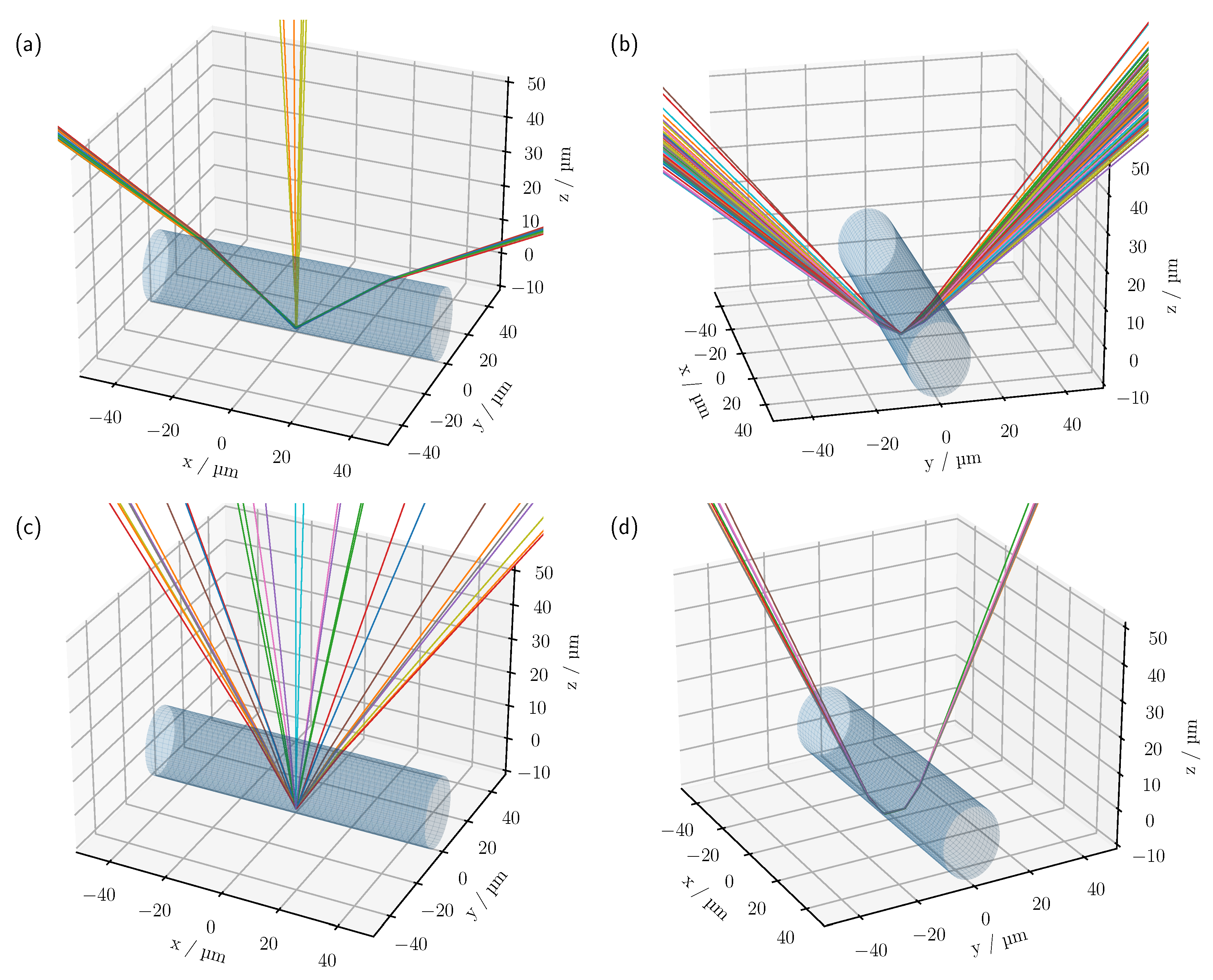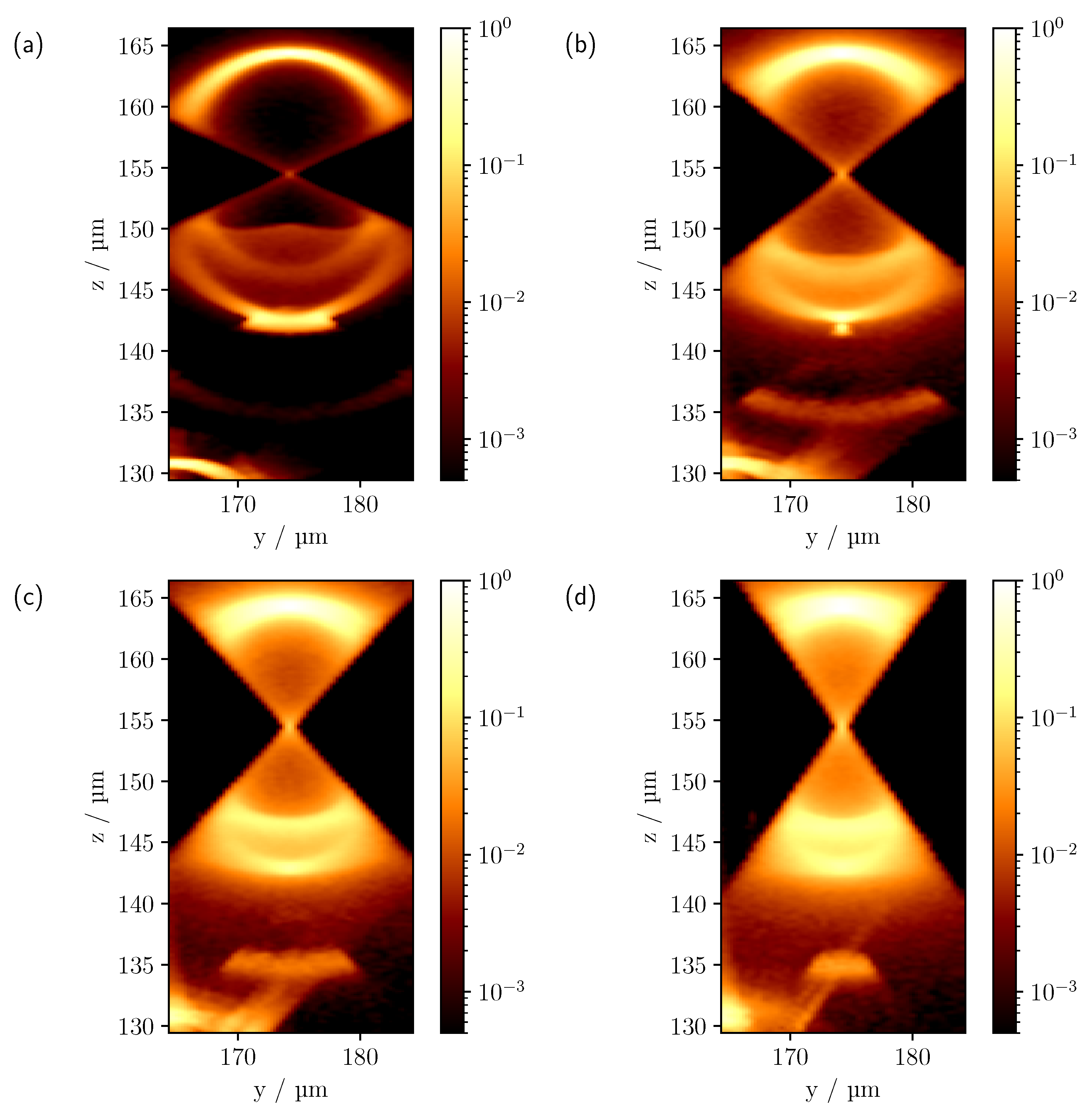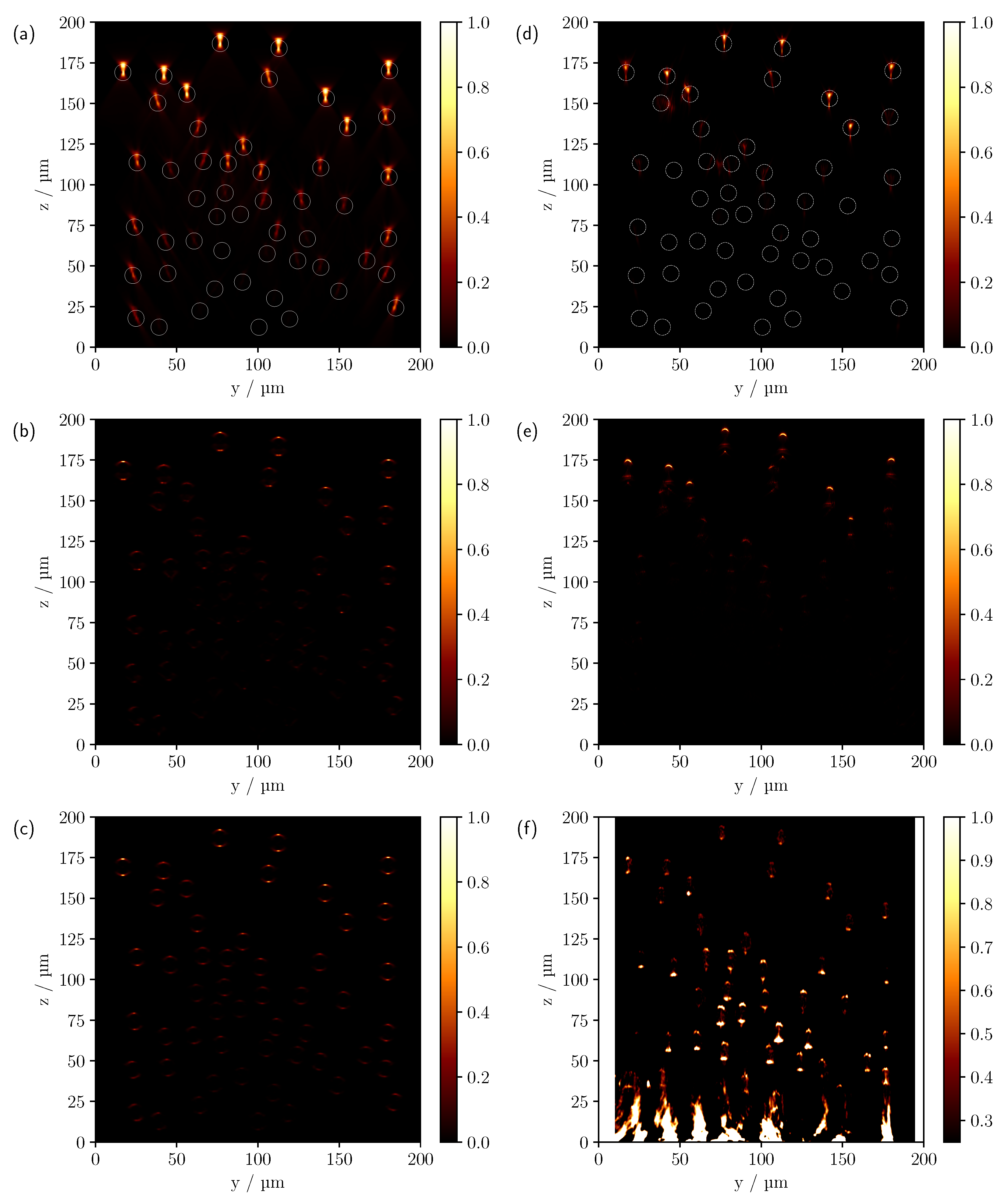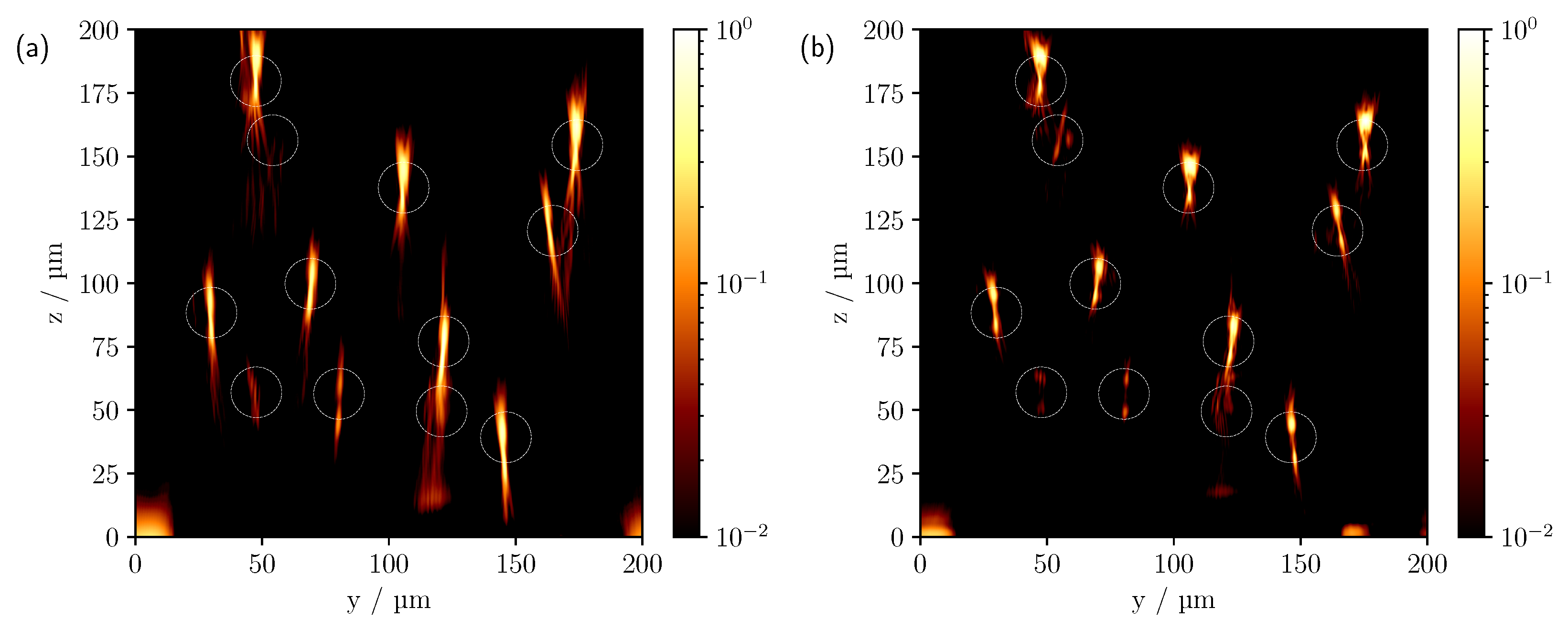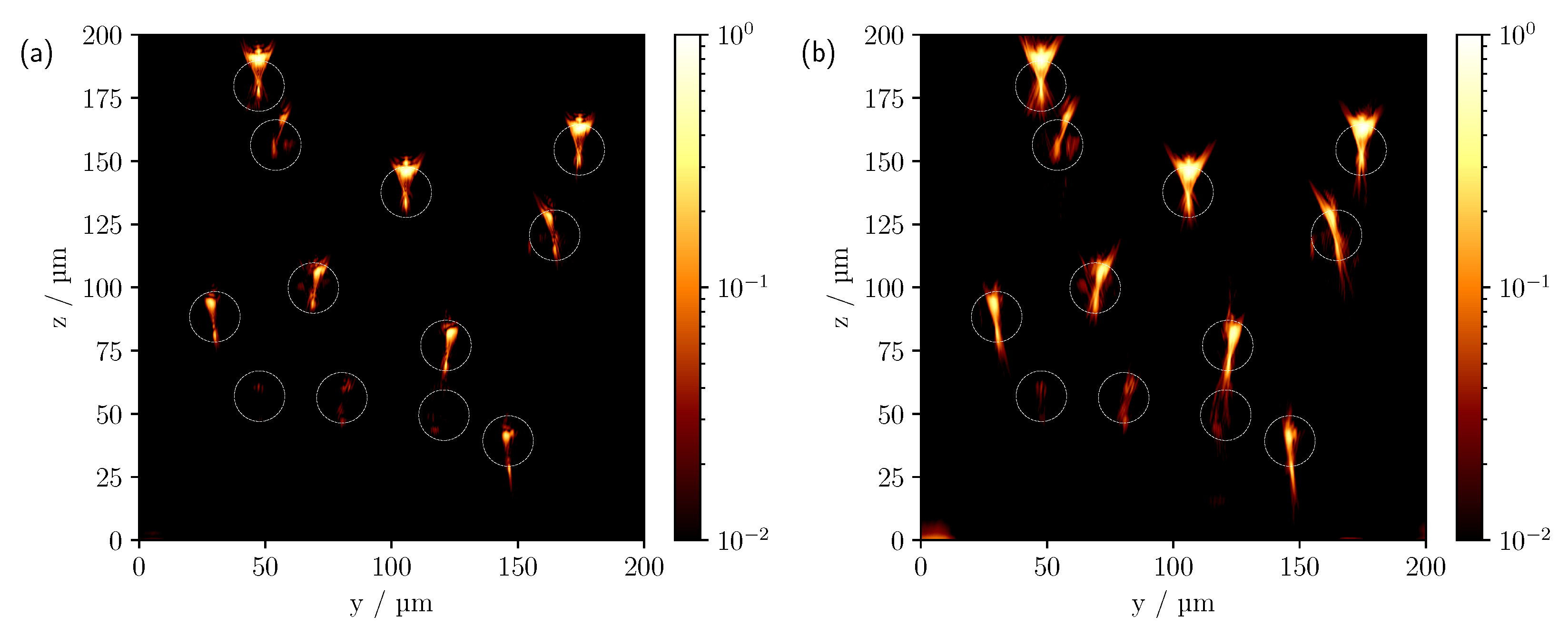3.2. Variation of the Refractive Index Difference
The experimental CLSM image stacks were acquired as described in
Section 2.1 at a resolution of
pixels by scanning the focus of the incident beam in all 3 directions. The two multi-cylinder geometries were measured both with an air objective with
and with an oil objective in immersion oil with
. Considering both materials used for 3D printing and assuming a refractive index of
for the immersion oil, the differences in refractive index
for the individual measurements are
,
,
and
. As the image characteristics are similar to those at
, the measurements at a refractive index difference of
are not considered in the following. For better statistics, all measurements were averaged over 40 scans along the
x-axis. In addition, the background noise was subtracted line by line. The resulting images were then normalised to the maximum intensity. Further filtering using a moving average with a window width of 5 pixels was applied to the measurements with the smallest refractive index difference of
to improve the signal-to-noise ratio. In this case, due to strong reflections on the glass substrate, the intensity was normalised to the signal from the first cylinder surface.
For the simulation, y-z scans were computed with a resolution of pixels for the smaller and for the larger . In order to improve the visibility of the signals, an up-scaling of the lateral resolution by a factor of two has been applied by means of cubic interpolation. The number of photons per pixel for a refractive index difference of 0.6285 and 0.1105 was , while for the lowest refractive index difference 0.0048, the photon count was to compensate for the low reflectance. The scattering coefficient and the absorption coefficient were fixed to zero for all simulations neglecting volume scattering and absorption. Using the surface meshes created for 3D printing, tetrahedral meshes were generated to model the multi-cylinder structures, excluding the support frames around the cylinders required for 3D printing. The spatial discretisation of the cylinders using tetrahedra was fine-tuned so that no deviations from analytically implemented cylinders could be detected. Based on the experimental setup, a numerical aperture , focal length and pinhole radius were assumed for the simulation with air as the surrounding medium (). For the remaining simulations with immersion oil as the external medium ( and ), the parameters , and were used.
The comparison between simulated (left panel) and measured (right panel) CLSM scans can be seen in
Figure 4 for different refractive index differences for the multi-cylinder geometry with cylinder radii of 10
.
Starting with measurements in air and
, first row, a good agreement between theory and experiment can be observed. In both
Figure 4a,d, the first free-standing cylinders show a reflection on the surface and a central focusing point inside the cylinders, which was expected from the results of the comparison made in
Figure 3. As a consequence of the significant difference in refractive index to the surrounding medium, the signals from the lower cylinders are shadowed by the cylinders above them. Three of the four lowest cylinders are barely visible in the experimental scan, presumably due to the presence of surface roughness of the superjacent cylinders caused by the printing process and the resulting higher scattering in the backward direction. In addition, despite the laterally enlarged support frame of the 3D print, there may be an effective reduction in NA due to shadowing, especially for the outer and deeper cylinders, and consequently an intensity decrease with depth. It can also be seen that the theoretical cylinder positions shown in white circles do not correspond exactly to the measured positions, which can be explained by a tilted sample. An examination of the
x-
z scans confirmed this assumption. Note that due to the alignment of the cylinders along the
x-axis, the image features in the
x-
z projection are invariant along
x, provided the cylinders are ideally aligned along the
x direction. In order to make the image features more apparent, a logarithmic representation of the comparison is shown in
Figure 5a,c. To compensate for the increased experimental intensity attenuation in the logarithmic plot, each pixel was multiplied by an empirically determined factor of five in
Figure 5c, indicating a good qualitative agreement also for the lowest cylinders.
With the reduction of
to
, see
Figure 4b,e, each cylinder in the model can be clearly identified in the simulated CLSM image. The higher NA of the oil objective results in a lateral broadening of the surface reflexes. However, compared to the experiment, the simulated surface reflection shows a maximum in the central area of the top of the cylinder, where the surface normals are still approximately parallel to the
z-axis, with the intensity decreasing towards the outside. This is to be expected when geometric optics are considered. As there are no ideal surfaces in the experiment as is the case in the simulation, the surface reflection also shows a higher intensity laterally. In addition, a signal can now be seen on the underside of the cylinders in
Figure 4b,e. Note that previously visible signals, such as the central focus-like spot as in
Figure 4a,d, are not visible in this linear representation because the ratio of the different feature intensities varies significantly as the optical system parameters and the reflectance index difference change. As with the measurement in air, there is a faster decrease in intensity with depth in the experiment. Again, increased surface scattering may be a factor. With the higher NA of the oil objective, the surrounding support structures of the phantom are also expected to reduce the effective NA and therefore the detected intensity compared to the simulation, especially for lower-lying cylinders. This is particularly clear for cylinders at the edge that are only partially shadowed by cylinders above them, such as the cylinder at
in
Figure 4b. Yet, in comparison to the upper row of cylinders, only a very faint signal can be detected. Without shadowing from the support structures, a clearly discernible signal from the outer surface would be expected in such a case. Other effects that cannot be described by the ideal numerically implemented optical system, such as various aberrations and a Gaussian beam, could also contribute to this signal reduction. After compensating for the increased intensity drop by pixel-wise multiplication by an empirically determined factor of three and the logarithmic display, see
Figure 5d, most of the lower-lying cylinders are now visible in the experimental scan. The logarithmic plot reveals further reflexes on the underside of the cylinders. One prominent signal appears about 8
below the centre of the cylinder, as already seen in the linear view, and a second about 2
below the lower surface of the cylinder; see, for example, the cylinder located at
. Analysing the individual photon paths within the MC simulation shows that these two signals mainly occur as follows: refraction on the surface of the cylinder, reflection on the underside of the cylinder and, after further refraction, incidence on the lens, see
Figure 6b,c.
For the reflex that results from a CLSM focus at about
, see
Figure 6b, the rays enter and leave the cylinder mainly laterally. In contrast, for a light source focused at
, the rays tend to be directed along the cylinder axis, see
Figure 6c. Apart from these 2 features, another discrete signal is visible for the simulation in
Figure 5b at about
below the centre of the cylinder. Again, the trajectories of the rays tend to follow the length of the cylinder, but at a larger angle than in the previous case, see
Figure 6a. In addition, the measurements in
Figure 5d show a focus-like point below the cylinders, which is not visible in the simulations; for example, see the cylinder located at
. The reason for this could again be a reduced effective NA in the experiment. An important indication of this is the decreased extent of the hourglass-shaped intensity profile in the experimental scan compared to the calculated image. For example, when the NA is reduced within the simulation, a similar focus-like spot could be reproduced below the cylinders in addition to a narrowing surface signal, see
Figure 7.
Shading caused by the supporting structure would effectively reduce the NA and explain the observed variations. The real Gaussian intensity distribution and deviations from the ideal optical system could also lead to a reduction in the effective NA compared to the simulation. Given that a larger NA also includes the angular range of a smaller NA, and provided that there are no interference effects responsible for the formation of this signal, it is expected that rays will reach the detector in the simulated scan when the CLSM is focused
below the centre of the cylinder, as seen in
Figure 6d and
Figure 7a. However, since at
the intensity of the signal located about
below the cylinder centre is orders of magnitude below the intensity of the remaining signals, it is not visible in the scaling chosen in
Figure 5b. Therefore, if geometrical optics is consulted once again, the formation of the lower focus-like signal can be traced back to multiple reflections inside the cylinder, see
Figure 6d. In general, it should be noted that the intensity characteristics of a single cylinder are very sensitive to the optical properties and parameters of the imaging system, as can be seen in
Figure 7.
For the smallest refractive index difference of
, see
Figure 4c,f, all cylinders are now clearly visible in both the simulated and measured CLSM image, even in the linear representation. Note, however, that intensity values less than 0.25 were truncated in the experimental scan for better comparability of the image features. The reason for this will be discussed below. Both scans show intensities only at the upper and lower interfaces to the medium owing to the minimal refraction. Since the difference in refractive index between the surrounding medium and the glass substrate located at
is about an order of magnitude greater than the difference in refractive index between the medium and the cylinders, pronounced artefacts due to reflections from the glass surface can be seen in the lower part of the image in case of the experimental results, see
Figure 4f. Overall, an increase in penetration depth was observed as the refractive index difference decreases. Qualitatively, this was explained in the previous discussion of the results by the reduction in reflectivity and lower refraction, with the implication that graphically speaking, the irradiated focus becomes less dispersed as it passes through the phantom and is, therefore, more preserved as it reaches the deeper-lying cylinders. Quantitatively, this observation can also be understood in terms of the scattering by a cylinder based on solving Maxwell’s Equations [
24], more specifically by calculating the scattering efficiency and scattering functions for the different cylinder radii and refractive index differences being investigated. When looking at the scattering efficiency first, it is about 3 times higher for the largest refractive index difference of
than for the smallest refractive index difference of
. However, the effect on the scattering function is far more critical; more specifically, when the refractive index difference is reduced from
to
, the ratio between forward to backward scattering increases dramatically. There is an intensity decrease of about 2 orders of magnitude between forward and backward scattering for
, 4 orders of magnitude for
and 7 orders of magnitude for
. In essence, by reducing the refractive index difference, proportionally less light is scattered backwards, allowing more light to reach the lower-lying cylinders.
If the phantoms with individual cylinder radii of 5
are now considered, which approximately halves the one-dimensional scattering cross section compared to the larger cylinders, the reduced cylinder size allows the number of individual scatterers to be increased from 12 to 51 within the volume of interest, see
Figure 8. As a result, there are now about four times as many scatterers and a change in the scattering function can also be anticipated.
At the largest refractive index difference of 0.6285, see
Figure 8a,d, a reduction in penetration depth compared to the previous phantom can be observed in both the simulation and the measured scan as a result of the increase in scatterers. In addition, for the smaller cylinder radii, there is also a subtle blurring of the individual intensity features, as the pinhole size is now larger in proportion to the dimension of the cylinder. Furthermore, for the phantom with individual cylinder radii of
the experiment shows that the intensity decreases more strongly with increasing depth, except for the measurements with the smallest refractive index difference. As previously discussed, this is likely to be due to a number of factors, including additional surface scattering, shading caused by the support geometry and deviations from the ideal assumed optical system. The shading appears to be one of the main causes when looking at the side cylinders in
Figure 8a,d. The outer cylinders are only partially shadowed by the other cylinders above them. Therefore, partial intensity features are to be expected beyond the shaded regions. Comparison with the simulation, which shows clearly visible signals for the lateral cylinders, confirms this. Nevertheless, the logarithmic plot,
Figure 9a,c, shows that after compensating for the increased intensity loss by multiplying the experimental scan by an empirically determined constant factor of five, the image features now show good agreement with the simulation.
Looking at the refractive index difference of 0.1105,
Figure 8b,e, one can also see the deviations already discussed, especially the barely visible cylinders at the edge of the phantom. As far as the signal characteristics are concerned, once again a good agreement between the simulation and the experiment can be observed in the linear representation. Again, only the lower focus-like point is missing in the simulation. As with the cylinder phantom with radii of 10
at a refractive index difference of 0.1105, there are obvious differences between the theory and the measurement when the CLSM scans are plotted on a logarithmic scale, see
Figure 9b,d. Here, too, an effective reduction in the NA would provide an explanation for the differences. For the smallest refractive index difference, see
Figure 8c,f, apart from the artefacts caused by reflections from the glass surface, all cylinders are again visible in both scans despite the increase in scatterers. However, in the upper right corner, see
Figure 8f, a cylinder appears to have been broken off during the printing or measuring process. As for the larger cylinders, values smaller than 0.25 were not taken into account for the presentation of the measurements with
, which was motivated by the following. When the full range of values is considered, the contribution of volume scattering within the cylinders becomes visible, see
Figure 10. This has been neglected in the comparison between the experiment and simulation as no scattering in the cylinder volumes was assumed in the latter. Due to the short path lengths and the completely filled cylinder volumes in 3D printing, no significant contribution from volume scattering is expected in principle and is negligible compared to the surface contributions, especially for measurements with higher refractive index differences. Nevertheless, for the smallest refractive index difference, the reflectance caused by the cylinder surface decreases significantly and the volume scattering signal component becomes comparatively more relevant to the overall image. The cause of the volume scattering is likely to be minimal heterogeneities in the cylinder volume created during the printing process. As seen previously for the larger cylinders, the ratio of forward to backward scattering also increases significantly for the smaller cylinders as the refractive index difference decreases to
. Although in this case, the scattering efficiency increases about tenfold from a refractive index difference of
to
, the influence of the refractive index difference on the phase function is still more substantial and would also explain the increase in penetration depth here, which is analogous to the larger cylinders.
